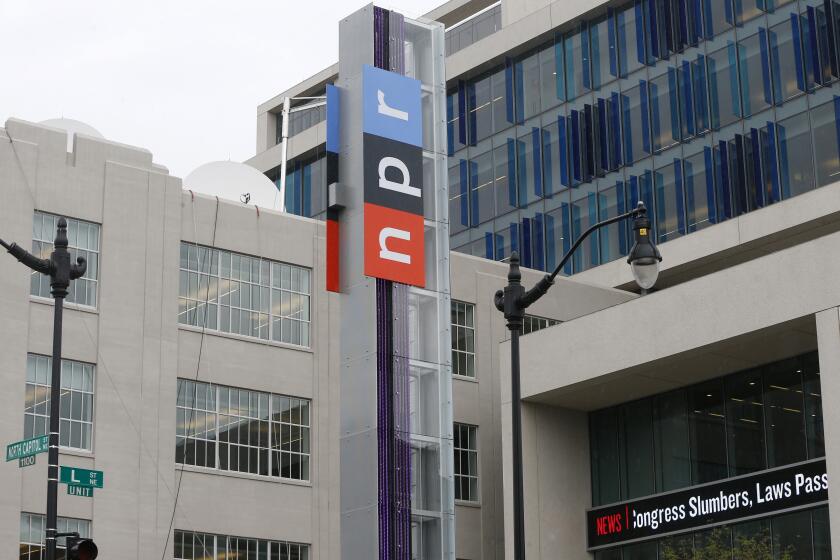Engaging fable contrasts 1960s ideals with age of greed
- Share via
The 1960s are a decade that has been (to borrow a once-fashionable academic term) “reified” on both sides of the political spectrum: by the nostalgic left as a golden age of hope and idealism, by the affronted right as a chaotic carnival of decadence, anarchy and self-delusion.
In “The Here and Now,” an engaging fable about a cynical, wildly successful corporate lawyer whose well-oiled life is suddenly disrupted by memories of his youthful ‘60s idealism, Gregg Easterbrook uses the earlier era as a symbol of integrity and altruism in contrast to the current age of trickery and unbridled greed. But despite a tendency to oversimplify that is inherent in writing a fable, Easterbrook, a senior editor at the New Republic and a contributing editor to Atlantic Monthly, manages to get beyond such black-and-white thinking.
Having enjoyed a brief shining moment as the nonviolent “Daffodil Man” of the antiwar movement and lover of the spirited and principled activist Jayne Anne LaMonica, Carter Morris has become the kind of man he and she would have once despised. At present, he is working out a sweetheart deal with the aptly named Value Neutral clothing company, which has become the subject of a class-action lawsuit.
The company has been charged with using an unapproved chemical substance called Simu-Sweat (to give its sportswear that coveted wet look whether the person wearing it actually bothers to exercise). Carter has been handpicked by Value Neutral as the lawyer to represent the class of injured consumers. The settlement deal will include an astronomically large sum to Carter and his law firm, and some measly discount coupons for the consumers on whose behalf the lawsuit was purportedly filed.
What happened to Carter’s youthful ideals? The young man who once ridiculed the work ethic has buried those ideals under a ton of work: “The age group to which Carter belonged grew up detesting the fifties-style institutional culture of conformism, yet the new institutional culture it created was just as inimical. Careerism ... the cell phone ... the tyranny of the stock price; his enlightened peers bowed to them all.”
While working on the Value Neutral case, Carter suddenly begins having weird, inexplicable episodes during which he seems to go back in time to earlier versions of himself. Although the net effect of this time travel is to reawaken his lost idealism, it also enables him -- and us -- to understand how and why many of these idealists so easily transformed themselves into cynical careerists.
Some, it seems, weren’t really very nice in the first place. For example, Carter’s least favorite fellow activist, Marshall Lelchuck, is making a fortune buying up land for malls: His pet project is to build a theme park called Gates of Hell, with virtual-reality chambers in which kids can play killers from psycho movies or watch holograms of their friends and families being slashed by crazed stalkers. Yet others, like Carter’s lost love Jayne Anne, have continued the quest to make the world a better place. The free-spirited girl who had championed love not war and defused many a tense situation in the 1960s is now running a home for children whose parents are in jail. Indeed, it would seem that genuine idealists like Jayne have not changed with the times, just as the vicious and opportunistic members of the movement are now vicious, opportunistic pillars of the establishment.
As for Carter, like many of his generation, he may have had too easy a childhood. Discouraged by his experiences in criminal law, Carter opted for the easy and lucrative way out, then tried to rationalize his choice by chalking it up to the temper of the times. Easterbrook seems to suggest that many of Carter’s generation, conditioned by the affluent society that bred them to expect instant gratification, quickly lost interest when the millennium didn’t materialize.
Easterbrook gets in some good satirical licks against a variety of reprehensible targets, from venal lawyers to corporations happy to shower money on high-priced executives or celebrity endorsements but that would “sooner die than give an extra dime to a seamstress in Vietnam.”
But he has some subtler points to make. Greed and venality are not the only problem. More insidious is the way that people have been led to believe that economic injustice is inevitable: “[W]hat if the economists were right and closing sweatshops just meant the people who once toiled there would be even worse off?” Carter wonders. “The sort of international fair-wage agreements that would resolve this dilemma to everyone’s mutual benefit seemed hopelessly utopian. Carter let the idea go. It was a fight for somebody else to take on.”
Reading “The Here and Now” is rather like attending a pep rally against this kind of defeatism. As Carter travels between his hopeful youth and his cynical current self, he finally realizes that the real danger is thinking in terms of “decades” or “periods.” Blaming the times instead of ourselves cuts us off from our ideals and identities, depriving us of the opportunity to act in the here and now.
*
The Here and Now
A Novel
Gregg Easterbrook
Thomas Dunne/St. Martin’s: 246 pp., $23.95
More to Read
The biggest entertainment stories
Get our big stories about Hollywood, film, television, music, arts, culture and more right in your inbox as soon as they publish.
You may occasionally receive promotional content from the Los Angeles Times.










